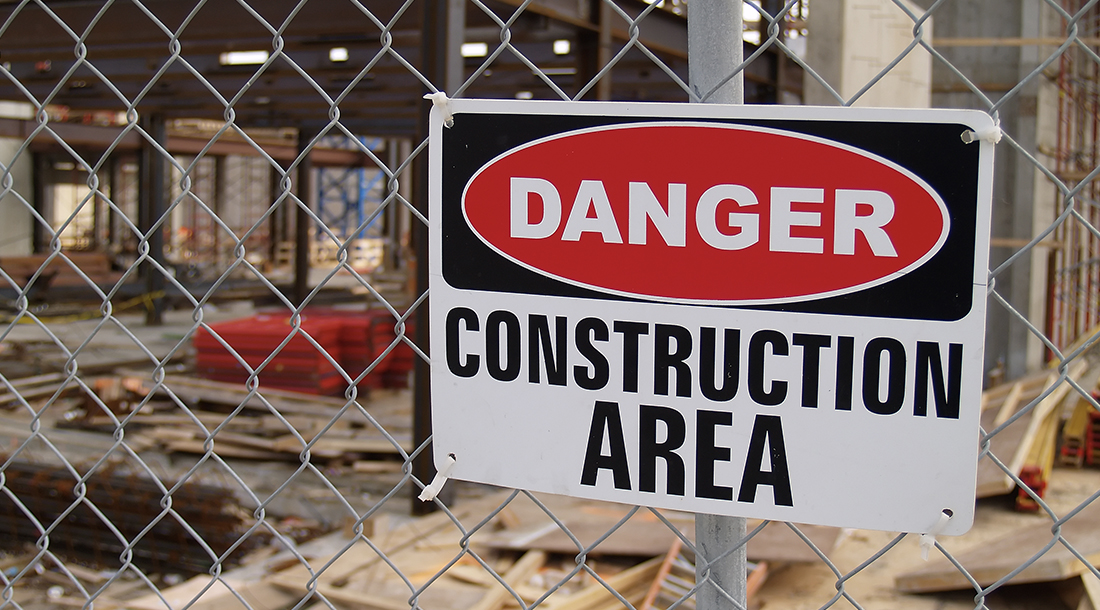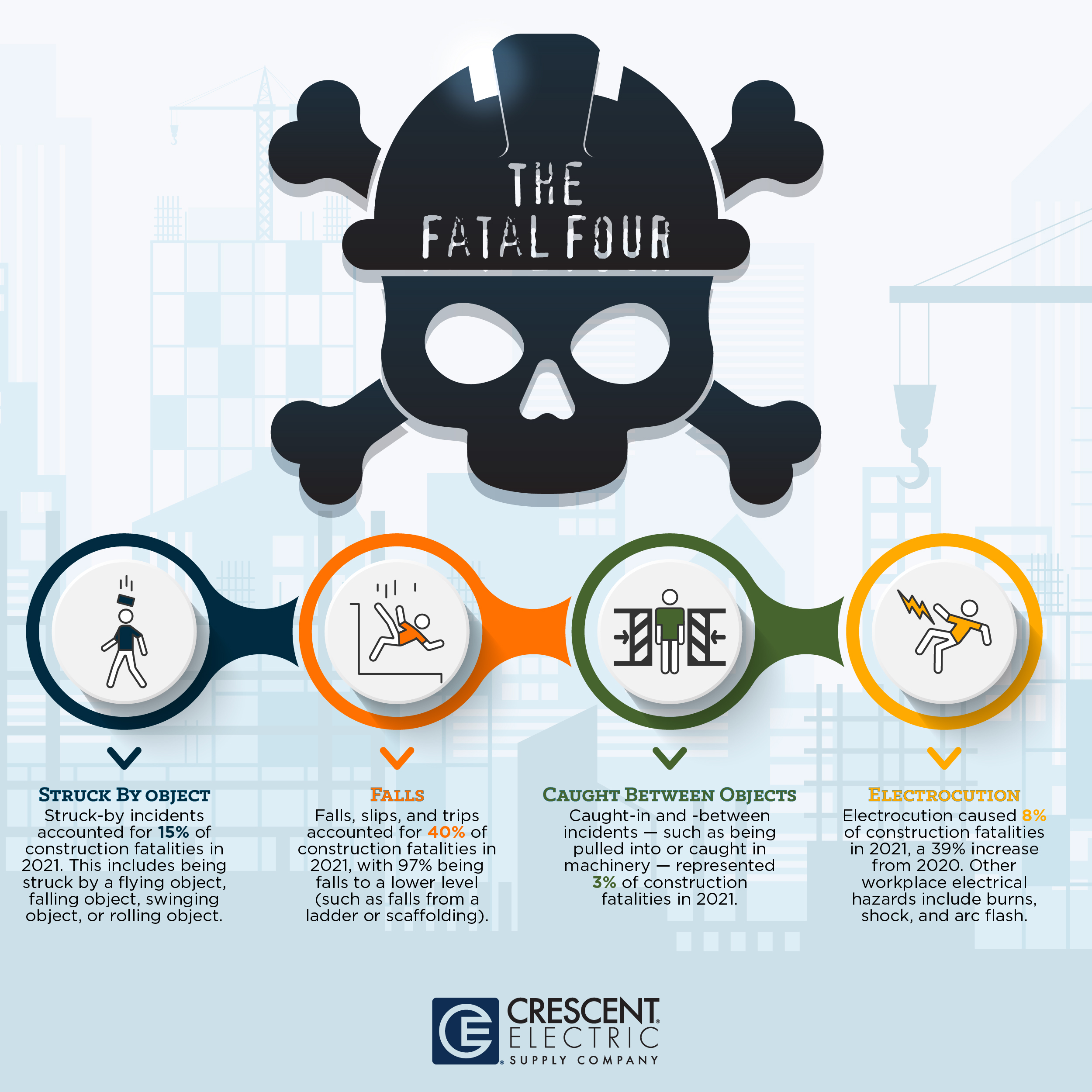
OSHA’s Fatal Four and How to Prevent Them
The inception of OSHA in 1970 paved the way for a dramatic decrease in overall workplace fatalities. That said, the risk of serious injury or death on the job is ever-present, especially in the construction industry.
Of the 5,190 workers that died on the job in 2021, 986 worked in construction and extraction occupations. With nearly 20% of workplace fatalities being attributed to the construction industry, it’s incredibly important for workers in the industry to understand what to look out for and how to stay safe on the job. That’s where OSHA’s Fatal Four comes in.
Let’s look at what the Fatal Four are and how to prevent them.
What are the Fatal Four?
OSHA identified the four leading causes of workplace deaths in the construction industry — known as the Fatal Four or Focus Four — to raise awareness about these hazards and promote safety on the job.
The Fatal Four are:
Falls
Falls are the leading cause of workplace fatalities in the construction industry. OSHA defines a fall hazard as “anything at your worksite that could cause you to lose your balance or lose bodily support and result in a fall.”
There are two primary types of falls: falls to a lower level (such as falls from a ladder or scaffold) and falls on the same level (also called slips and trips). Falls, slips, and trips accounted for approximately 40% of all construction industry workplace fatalities in 2021, with 97% being falls to a lower level.
Caught-in or -between
OSHA defines caught-in or -between incidents as “injuries resulting from a person being squeezed, caught, crushed, pinched, or compressed between two or more objects, or between parts of an object.” This includes events such as being pulled into or caught in machinery or cave-ins.
Caught-in or -between incidents accounted for about 3% of construction industry workplace fatalities in 2021.
Struck-by
Struck-by incidents can be similar to caught-in or -between incidents, but there is one main distinction: if the impact of an object alone caused the injury, it is classified as struck-by. Therefore, OSHA defines struck as “injuries produced by forcible contact or impact between the injured person and an object or piece of equipment.”
There are four main categories of struck-by hazards:
- Struck-by flying object
- Struck-by falling object
- Struck-by swinging object
- Struck-by rolling object
In 2021, there were 150 stuck-by fatalities in the construction industry, making them the second-highest fatality type behind falls.
Electrocution
The final of OSHA’s Fatal Four hazards is electrocution. Electrocution occurs when “a person is exposed to a lethal amount of electrical energy.” This may occur due to contact with overhead power lines, live parts, defective equipment, and more.
Electrocution is just one of the electrical hazards that construction workers may encounter on the job. To promote electrical safety in the construction industry, OSHA created the acronym BE SAFE:
- Burns: electrical, arc/flash, or thermal contact burns
- Electrocution: exposure to a lethal amount of electricity
- Shock: a reflex response to the passage of electrical current through the body
- Arc Flash/Blast: the sudden release of electrical energy through the air caused by a breakdown between conductors
- Fire: electrical fire, commonly caused by faulty or old wiring
- Explosions: the result of electricity igniting an explosive mixture of material in the air
In 2021, 75 construction industry workers died by electrocution, a 39% increase from 2020.

How to Prevent the Fatal Four
There’s no way to eliminate hazards from construction industry work, but the Fatal Four campaign is designed to inform and educate workers on how to minimize risk factors and protect themselves on the job. Let’s look at some key strategies for preventing each Fatal Four hazard.
Fall Prevention
Given the nature of construction work, nearly all jobsites have unprotected roof edges, floor openings, and other major fall hazards at some point in the process. OSHA requires that fall protection be provided at six feet for construction work, including guardrails, safety nets, and/or personal fall arrest systems. If these protections are not present at six feet or higher (or 10 feet or higher for scaffold work), this is a violation of OSHA standards and may be reported.
Ladders are another common fall hazard in construction. Injury or death from ladder falls is generally preventable by following ladder safety guidelines. Tips such as securing the base of the ladder, not working on the top rung, and always using the right ladder for the job are designed to save lives — always follow these and other recommended safety guidelines while using ladders.
Caught-in or -between Prevention
Machinery that has moving or rotating parts is a major caught-in or -between hazard. Therefore, ensure that all machinery is properly guarded, and never wear loose clothing or anything else that may be caught in moving parts.
Additionally, always de-energize all equipment that is not in use. This includes disconnecting tools from power, turning off vehicles, and locking out the power source to large equipment when possible or necessary.
Excavation sites also present serious caught-in or -between hazards — cave-ins are a common cause of caught-in or -between fatalities. To protect yourself on excavation sites, don’t work in unprotected trenches that are deeper than five feet, and only enter or exit a trench using a ladder, stairway, or properly designed ramp.
Struck-by Prevention
Struck-by hazards are present on all jobsites, the specific type of hazard will depend on the nature of the work. In general, always wear proper personal protective equipment (PPE) such as safety glasses or hard hats, and routinely inspect your PPE to ensure there is no damage that could compromise its effectiveness.
When working around heavy equipment such as cranes or excavators, always be aware of the equipment’s location, don’t enter unsafe zones around equipment that is in use (such as the swing radius of cranes or backhoes), and never work beneath suspended loads. If operating the equipment, protect yourself and others by not exceeding a vehicle’s rated load or lift capacity, ensuring workers are in the clear before using dumping or lifting devices, and lowering or blocking blades, buckets, etc. when not in use.
Vehicles also present struck-by hazards on the jobsite. Protect yourself by wearing high-visibility reflective clothing, ensure that proper signage is posted, and never cross the path of a backing vehicle. When operating vehicles, always follow proper vehicle safety guidelines and be aware of others on your site.
Electrocution Prevention
It’s important for all in the construction industry — not just electricians and contractors — to always keep electrical safety tips top of mind. Always be vigilant about electrical hazards such as improper wiring, exposed parts, or any other potentially deadly conditions.
Power lines are a major hazard due to their extremely high voltage — always stay clear from power lines when possible. Never work within the minimum clearance distance for any power lines you must work near (minimum clearance distance is determined based on line voltage).
On a smaller scale, portable tools and extension cords also present potential electrical hazards. Always inspect tools and cords before use, checking for any damage or signs of age. Treat tools with care; never carry them by the cord or roughly pull the cord to disconnect from power. Utilize ground-fault circuit interrupters (GFCI).
Lastly, ensure that you and other workers are aware of the proper lockout/tagout procedures on your site.
Stay Safe with Help from Crescent Electric
The Fatal Four hazards will always be present for workers in the construction industry, but through proper training and care on the jobsite, these risks and be minimized. And while there’s still more work to be done, 2021 had the fewest Fatal Four fatalities since 2014.
Crescent Electric is also committed to helping you stay safe on the construction site. We offer a wide range of products designed to help you stay safe on the job and a lineup of services that can help make your jobsite safer and more secure, including arc flash audits.
Learn more about Crescent’s commitment to safety and security and contact us to partner with us today!